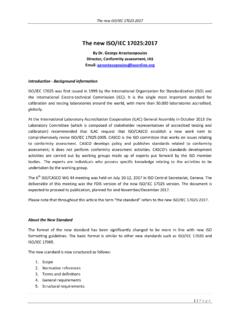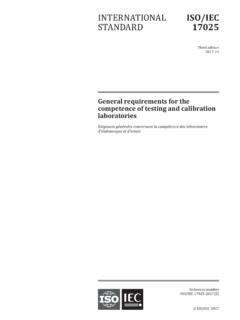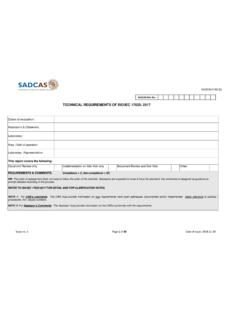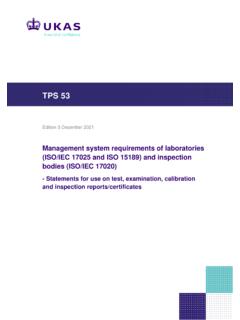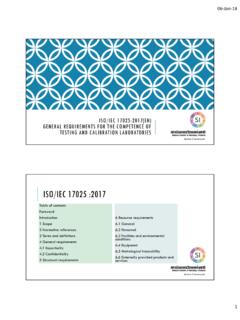Transcription of Risk Sample - ISO 17025 Store | ISO/IEC 17025 ...
1 1 Risk -Based Thinking In Laboratory Quality Management Systems ISO/IEC 17025 : 2017 Risk Management / Analysis of Risk Sample 2 Risk Management Earlier versions of standards for Laboratory Management Systems have advocated risk management and risk avoidance, but it has been implicit. The new ISO/IEC 17025 : 2017 standard explicitly expects organizations to consider and identify actions to address risks and opportunities associated with their laboratory operations, processes, and activities, aimed at and resulting in improved performance.
2 Besides identifying the risks, the ISO standard expects laboratories to address opportunities for improvements and corrective actions based on the risk analysis. Note that while corrective action is an ISO/IEC 17025 : 2017 requirement, the concept of preventive action is expressed through a risk-based approach where risks are determined and actions to address risks and opportunities are taken. The standard does not require you to create a formal risk management system. However, this risk analysis exercise is intended to outline several approaches / options for the management of risk for your laboratory.
3 To prepare for the change, it is important to understand Risk Based Thinking and begin to look at your operations, processes, and activities in terms of risks and opportunities. Risk is the possibility of an event or activity negatively impacting the operational or strategic objectives of an organization. When evaluating risk, it is helpful to address it using two (2) metrics or parameters: 1. Severity (if harm happens, how serious is the event),2. Likelihood (what is the probability of a harmful event). Sample 6 Prepare Test Protocol Flow Diagram The Process Flow Diagram for Accredited Work represents each step in a test protocol and includes other relevant factors associated with the steps.
4 Process Flow Relevant Factors 1. ReceiveSample 2. Sift, Grind,Extract, Dilute 3. Errors 1 lb. or grain to test for nutrient or pathogen, or regulated drug. Receiving inspection Technicians Lab Equipment Technologists Lab Automation Quality control Technician self-inspect Technologists Lab Equipment Monitoring and Analysis Technologists Lab Automation Monitoring and Analysis Technologists Lab Automation forLaboratory Services Monitoring and Analysis 4. AverageMultiple Repeat Measurements Monitoring, Analysis, and evaluation Technologists BlankTest 6.
5 Run SimilarReferenceMaterial ,Approve Reports Reports Monitoring, Analysis, and evaluation Sample 8 Exercise - Conduct Risk Analysis - Risk Management Worksheet Basic Method The first 6 columns of this form are used to list the Potential Risks and Assess the Significance of the Risks The last 2 columns of this form are used to indicate whether or not the Item / activity / process are at risk and require attention. *R efer to the Test Protocol Flow Diagram.** Where both the Severity and the Likelihood are high, the risk is significant, and the Item requires corrective Needing Attention What is present or could be introduced as a risk?
6 Description of Risk Risk Assessment 1 = Severity 2 = Likelihood 3 = Significance Does a next step in process eliminate the risk? What controls exist to address the risk? Is the Item / process step at risk? Yes / No If YES, Initiate Remedial Action *Aspect--- ** Impact--- Threat Opportunity --- --- ---- 1 2 3 Justifications ---- Compiled by LMS Team Leader: _____, Date: _____ LMS Team review: 1_____, Date: _____, 2_____, Date: _____ Sample 10 Exercise - Action 1 - Conduct Risk Analysis - Risk Management Worksheet ACTION 1 ACTION 2 ACTION 3 ACTION 4 ACTION 5 ACTION 6 ACTION 7 ACTION 8 Item Needing Attention Input Description of Risk Significance 1 = Severity 2 = Likelihood 3 = Significance Does a next step in process eliminate the risk?
7 What controls exist to address the risk? Is the Item / process step at risk? Yes / No If YES, Issue the Corrective Action Request --- --- ---- 1 2 3 Justifications ACTION 1 Item number and name Each Item identified on the Test Protocol Flow Diagram as needing attention needs to be transferred to this worksheet and numbered and named in the same sequence as in the flow diagram. This is to ensure that all aspects of the process are visible and controlled, not just the items that are at risk. Reviews can describe problem areas not only in a laboratory setting, but also sequential steps for administration and other management activities such as purchasing.
8 This risk management worksheet can be used to analyze the risks associated with those activities. Sample 25 Exercise - Conduct Risk Analysis - Risk Management Worksheet RPN method The first 6 columns of this form are used to list the Potential Risks and Assess the Significance of the Risks. The last 2 columns of this form are used to indicate whether or not the Item / process step is at risk and requires attention. * Refer to the flow diagrams where the processes are identified, described and the item / process steps detailed.
9 ** Refer to Frequency, Severity, and Detection Guidelines. ** Refer to Risk Category Guidelines in previous pages. * Step * What ispresent or could be introduced as a risk? Description of Risk ** Analysis ** F = Frequency S = Severity D = Detection Risk Potential Number F x S x D ** Risk ** 51 + = A 50 to 26 = B 25 to 16 = C 15 to 10 = D 9 to 1 = E Item / process step at risk Yes = A, B, C D, E = No If YES, Issue the Corrective Action Request --- --- ---- F S D CATEGORY YES NOCAR # Compiled by LMS Team Leader: _____, Date: _____ LMS Team review: 1_____, Date: _____, 2_____, Date: _____ SAMPLE1 Risk Management / Risk Analysis in ISO/IEC 17025 .
10 2017 Committed to Accurate and Valid Laboratory Results 2018 Includes Risk Power PointSAMPLET rivial Trivial Significant Major Catatstrophic Impact Not Like Possible QuitePossible LikelyVery Likely Likelihood Risk-Based Thinking An informal risk management system aimed at improvement 2 2018 SAMPLE3 Purchasing Process Single Source supplier is shut down by the onset ofa devasting earthquake What is the impact? You are shut down What is the likelihood it will happen? Unlikely (But it can happen) How do you mitigate the risk?
